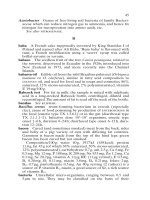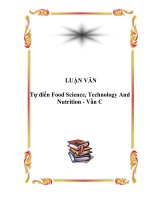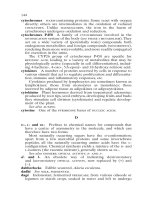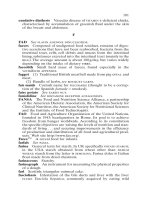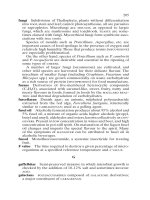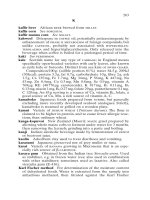Tự điển food science, technology and nutrition vần a
Bạn đang xem bản rút gọn của tài liệu. Xem và tải ngay bản đầy đủ của tài liệu tại đây (565.16 KB, 56 trang )
WOODHEAD PUBLISHING IN FOOD SCIENCE, TECHNOLOGY AND NUTRITION
Benders’ dictionary
of nutrition and
food technology
Eighth edition
David A. Bender
Benders’ dictionary of nutrition
and food technology
Related titles:
Food dehydration: A dictionary and guide
(ISBN-13: 978-1-85573-360-2; ISBN-10: 1-85573-360-9)
This authoritative guide examines the background and principles
of food dehydration as well as providing a complete dictionary of
food dehydration terms, with detailed definitions and a directory
of dehydrated foods. It is an ideal reference work for students of
food science as well as a quick and easy source of information
for food science professionals.
Food, diet and obesity
(ISBN-13: 978-1-85573-958-1; ISBN-10: 1-85573-958-5)
Obesity is a global epidemic, with large numbers of adults and
children overweight or obese in many developed and developing
countries. As a result, there is an unprecedented level of interest
and research in the complex interactions between our genetic
susceptibility, diet and lifestyle in determining individual risk of
obesity. With its distinguished editor and international team of
contributors, this collection sums up the key themes in weight
control research, focusing on their implications and applications
for food product development and consumers.
Improving the fat content of foods
(ISBN-13: 978-1-85573-965-9; ISBN-10: 1-85573-965-8)
Dietary fats have long been recognised as having a major impact
on health, negative in the case of consumers’ excessive intake of
saturated fatty acids, positive in the case of increasing consumers’
intake of long chain n-3 polyunsaturated fatty acids (PUFAs).
However, progress in ensuring that consumers achieve a
nutritionally optimal fat intake has been slow. This important
collection reviews the range of steps needed to improve the fat
content of foods whilst maintaining sensory quality.
Details of these books and a complete list of Woodhead’s titles
can be obtained by:
• visiting our web site at www.woodheadpublishing.com
• contacting Customer Services (e-mail: ; fax: +44 (0) 1223 893694; tel.: +44 (0) 1223
891358 ext. 30; address: Woodhead Publishing Ltd, Abington
Hall, Abington, Cambridge CB1 6AH, England)
Benders’ dictionary
of nutrition and food
technology
Eighth edition
David A. Bender
BSc, PhD, RNutr
Senior Lecturer in Biochemistry,
University College London
Cambridge, England
Published by Woodhead Publishing Limited, Abington Hall, Abington
Cambridge CB1 6AH, England
www.woodheadpublishing.com
Published in North America by CRC Press LLC, 6000 Broken Sound Parkway, NW
Suite 300, Boca Raton, FL 33487, USA
First published 1960
Second edition 1965
Third edition 1968
Fourth edition Newnes-Butterworth 1975
Fifth edition Butterworth Scientific 1982
Reprinted 1984
Sixth edition 1990
Reprinted 1998 Woodhead Publishing Limited
Seventh edition 1999, Woodhead Publishing Limited and CRC Press LLC
Eighth edition 2006, Woodhead Publishing Limited and CRC Press LLC
© 2006, Woodhead Publishing Limited
The author has asserted his moral rights.
This book contains information obtained from authentic and highly regarded
sources. Reprinted material is quoted with permission, and sources are indicated.
Reasonable efforts have been made to publish reliable data and information, but
the author and the publishers cannot assume responsibility for the validity of all
materials. Neither the author nor the publishers, nor anyone else associated with
this publication, shall be liable for any loss, damage or liability directly or
indirectly caused or alleged to be caused by this book.
Neither this book nor any part may be reproduced or transmitted in any form
or by any means, electronic or mechanical, including photocopying, microfilming
and recording, or by any information storage or retrieval system, without
permission in writing from Woodhead Publishing Limited.
The consent of Woodhead Publishing Limited does not extend to copying for
general distribution, for promotion, for creating new works, or for resale. Specific
permission must be obtained in writing from Woodhead Publishing Limited for
such copying.
Trademark notice: Product or corporate names may be trademarks or registered
trademarks, and are used only for identification and explanation, without intent
to infringe.
British Library Cataloguing in Publication Data
A catalogue record for this book is available from the British Library.
Library of Congress Cataloging in Publication Data
A catalog record for this book is available from the Library of Congress.
Woodhead Publishing ISBN-13: 978-1-84569-051-9 (book)
Woodhead Publishing ISBN-10: 1-84569-051-6 (book)
Woodhead Publishing ISBN-13: 978-1-84569-165-3 (e-book)
Woodhead Publishing ISBN-10: 1-84569-165-2 (e-book)
CRC Press ISBN-10: 0-8493-7601-7
CRC Press order number: WP7601
The publishers’ policy is to use permanent paper from mills that operate a
sustainable forestry policy, and which has been manufactured from pulp which is
processed using acid-free and elementary chlorine-free practices. Furthermore,
the publishers ensure that the text paper and cover board used have met
acceptable environmental accreditation standards.
Typeset by SNP Best-set Typesetter Ltd., Hong Kong.
Printed by TJ International Ltd, Padstow, Cornwall, England.
Contents
Preface
A note on food composition
vi
viii
List of figures
ix
Dictionary
1
Appendix:
523
Table 1 Units of physical quantities and multiples and
submultiples of units
Table 2 Labelling reference values for foods
Table 3 US/Canadian recommended dietary allowances
and acceptable intakes, 1997–2001
Table 4 EU population reference intakes of nutrients, 1993
Table 5 UK reference nutrient intakes, 1991
Table 6 Recommended nutrient intakes for vitamins, FAO
2001
Table 7 Food additives permitted in the EU
Table 8 Fatty acid nomenclature
525
526
527
528
529
530
531
539
Preface
The study of food and nutrition covers a wide range of disciplines, from agriculture and horticulture, through the chemistry,
physics and technology of food processing and manufacture
(including domestic food preparation), the physiology and biochemistry of nutrition and metabolism, molecular biology,
genetics and biotechnology, via social sciences and the law, anthropology and epidemiology to clinical medicine, disease prevention
and health promotion. This means that anyone interested in
food and nutrition will be reading articles written from a variety of
disciplines and hearing lectures by specialists in a variety of
fields. We will all come across unfamiliar terms, or terms that are
familiar but used in a new context as the jargon of a different
discipline.
At the same time, new terms are introduced as our knowledge
increases, and as new techniques are introduced, old terms become
obsolete, dropping out of current textbooks, so that the reader of
earlier literature may be at a loss.
All of this provides the raison d’être of this Dictionary, the first
edition of which was published in 1960, with definitions of 2000
terms. Over the years it has grown so that in this edition it includes
more than 6100 entries.
At the front of the first and following editions, there was the following note:
Should this book become sufficiently familiar through usage
to earn the title ‘Bender’s Dictionary’, it would probably be
more correct to call it ‘Benders’ Dictionary’, in view of the
valuable assistance of D., D.A. and B.G., guided, if not driven, by
A.E.
The publisher suggested that the seventh edition should indeed be
called ‘Bender’s Dictionary of Nutrition and Food Technology’. I
was proud that my father invited me to join him as a full co-author,
so that it could be called Benders’ Dictionary. Sadly he died in
February 1999, before the typescript of that edition was completed.
I hope that in this eighth edition I have done justice to his memory
and to the book that was the first of many that he wrote. For the
vii
first edition my main task was to read widely, and make a note of
terms I did not know. This is still my role, but now I have to find
the definitions as well.
David A. Bender
A note on food composition
This book contains nutrient composition data for 340 foods, from
the US Department of Agriculture National Nutrient Database
for Standard Reference, Release 17, which is freely available
from the USDA Nutrient Data Laboratory website: http://www.
nal.usda.gov/fnic/foodcomp/.
In addition to the nutrient content per 100 g, we have calculated
nutrient yields per serving, and shown the information as a note
that a specified serving is a source, good source or rich source of
various nutrients. A rich source means that the serving provides
more than 30%, a good source 20–30%, and a source 10–20% of
the recommended daily amount of that nutrient (based on the EU
nutrition labelling figures shown in Table 2 of the Appendix).
Any specified food will differ in composition from one variety to
another, and from sample to sample of the same variety, depending on the conditions under which the animal was raised or the
plant grown, so that the values quoted here should not be considered to be accurate to better than about ±10%, at best; the variation in micronutrient content may be even greater.
List of figures
The protein amino acids
Ascorbic acid and dehydroascorbate
Bile salts
Biotin
Carbohydrates: mono- and disaccharides
Carotenes
Cholesterol
Flavonoids
Folic acid
The gastrointestinal tract
dl- and cis–trans isomerism
Niacin
Non-starch polysaccharides
Pantothenic acid and coenzyme A
Purines
Pyrimidines
Starch
Vitamin A
Vitamin B1
Vitamin B2
Vitamin B6
Vitamin B12
Vitamin D
Vitamin E
Vitamin K
22
39
61
63
91
95
114
192
198
209
259
329
334
354
398
399
447
495
496
496
497
499
501
502
503
A
abalone A shellfish (mollusc), Haliotus splendens, H. rufescens,
H. cracherodii, also sometimes called ormer, or sea ear. Found
especially in waters around Australia, and also California and
Japan, the Channel Islands and France.
Composition/100 g: water 75 g, 440 kJ (105 kcal), protein 17 g,
fat 0.8 g, cholesterol 85 mg, carbohydrate 6 g, ash 1.6 g, Ca 31 mg,
Fe 3.2 mg, Mg 48 mg, P 190 mg, K 250 mg, Na 301 mg, Zn 0.8 mg,
Cu 0.2 mg, Se 45 µg, vitamin A 2 µg retinol, E 4 mg, K 23 mg,
B1 0.19 mg, B2 0.1 mg, niacin 1.5 mg, B6 0.15 mg, folate 5 µg, B12
0.7 µg, pantothenate 3 mg, C 2 mg. An 85 g serving is a source of
Cu, Fe, Mg, vitamin B1, a good source of P, a rich source of Se,
vitamin E, B12, pantothenate.
abscisic acid Plant hormone with growth inhibitory action; the
dormancy-inducing hormone, responsible for shedding of leaves
by deciduous trees. In herbaceous plants can lead to dwarf or
compact plants with normal or enhanced fruit production. Used
horticulturally to inhibit growth, and as a defoliant.
absinthe A herb liqueur flavoured with wormwood (Artemisia
absinthium); it is toxic and banned in many countries. Originally
imported from Switzerland (where it was a patent medicine) to
France in 1797 by Henri Louis Pernod; sale outlawed in USA in
1912, and in France and other countries in 1915 because of the
toxicity of α-thujone. Now available in the EU with an upper
limit of 10 ppm thujone.
absolute alcohol Pure ethyl alcohol.
absorption spectrometry Analytical technique based on
absorbance of light of a specific wavelength by a solute.
acarbose The name of a group of complex carbohydrates
(oligosaccharides) which inhibit the enzymes of starch and disaccharide digestion; used experimentally to reduce the digestion
of starch and so slow the rate of absorption of carbohydrates. Has
been marketed for use in association with weight-reducing diet
regimes as a ‘starch blocker’, but there is no evidence of efficacy.
acaricides Pesticides used to kill mites and ticks (Acaridae) which
cause animal diseases and the spoilage of flour and other foods
in storage.
2
accelase A mixture of enzymes that hydrolyse proteins, including an exopeptidase from the bacterium Streptococcus lactis,
which is one of the starter organisms in dairy processing. The
mixed enzymes are used to shorten the maturation time of
cheeses and intensify the flavour of processed cheese.
accelerated freeze drying See freeze drying.
Acceptable Daily Intake (ADI) The amount of a food additive
that could be taken daily for an entire lifespan without appreciable risk. Determined by measuring the highest dose of the
substance that has no effect on experimental animals, then dividing by a safety factor of 100. Substances that are not given an
ADI are regarded as having no adverse effect at any level of
intake.
See also no effect level.
accoub Edible thistle (Goundelia tournefortii) growing in
Mediterranean countries and Middle East. The flower buds when
cooked have a flavour resembling that of asparagus or globe
artichoke; the shoots can be eaten in the same way as asparagus and the roots as salsify.
accuracy Of an assay; the closeness of the result to the ‘true’
result.
See also precision.
ACE Angiotensin converting enzyme (EC 3.4.15.1), a peptidase
in the blood vessels of the lungs which converts angiotensin I to
active angiotensin II. Many of the drugs for treatment of hypertension are ACE inhibitors.
acerola See cherry, west indian.
acesulphame (acesulfame) Methyl-oxathiazinone dioxide, a nonnutritive or intense (artificial) sweetener. The potassium salt,
acesulphame-K, is some 200 times as sweet as sucrose. It is not
metabolised, and is excreted unchanged.
acetanisole A synthetic flavouring agent (p-methoxyacetophenone) with a hawthorn-like odour.
acetic acid (ethanoic acid) One of the simplest organic acids,
CH3COOH. It is the acid of vinegar and is formed, together with
lactic acid, in pickled (fermented) foods. It is added to foods
and sauces as a preservative.
Acetobacter Genus of bacteria (family Bacteriaceae) that oxidise
ethyl alcohol to acetic acid (secondary fermentation). Acetobacter pasteurianus (also known as Mycoderma aceti, Bacterium
aceti or B. pasteuranum) is used in the manufacture of vinegar.
acetoglycerides One or two of the long-chain fatty acids esterified to glycerol in a triacylglycerol is replaced by acetic
acid. There are three types: diacetomonoglycerides (e.g. diacetomonostearin); monoacetodiglycerides (e.g. monoacetodis-
3
tearin); monoacetomonoglycerides (e.g. monoacetomonostearin) in which one hydroxyl group of the glycerol is free. Also
known as partial glyceride esters.
They are non-greasy and have lower melting points than the
corresponding triacylglycerol. They are used in shortenings and
spreads, as films for coating foods and as plasticisers for hard fats.
acetohexamide Oral hypoglycaemic agent used to treat noninsulin-dependent diabetes mellitus.
acetoin Acetyl methyl carbinol, a precursor of diacetyl, which is
one of the constituents of the flavour of butter. Acetoin and
diacetyl are produced by bacteria during the ripening of butter.
acetomenaphthone Synthetic compound with vitamin k activity;
vitamin K3, also known as menaquinone-0.
acetone One of the ketone bodies formed in the body in fasting.
Also used as a solvent, e.g. in varnishes and lacquer. Chemically
dimethyl ketone or propan-2-one ((CH3)2C=O).
acetylated monoglyceride An emulsifier manufactured by interesterification of fats with glyceryl triacetate (triacetin) or acetylation of monoglycerides with acetic anhydride. Characterised by
sharp melting points and stability to oxidative rancidity.
acetylcholine The acetyl ester of choline, produced as a neurotransmitter at cholinergic nerve endings in the brain and at neuromuscular junctions.
achalasia Difficulty in swallowing owing to disturbance of the
normal muscle activity of the oesophagus, sometimes causing
regurgitation and severe chest pain. Also known as cardiospasm.
achene Botanical term for small, dry one-seeded fruit which does
not open to liberate the seed, e.g. nuts.
ACH index Arm, chest, hip index. A method of assessing a
person’s nutritional status by measuring the arm circumference,
chest diameter and hip width.
See also anthropometry.
achlorhydria Failure of secretion of gastric acid and intrinsic
factor, which are secreted by the gastric parietal (oxyntic) cells.
Commonly associated with atrophy of the gastric mucosa with
advancing age.
See also anaemia, pernicious; gastric secretion.
acholia Absence or deficiency of bile secretion.
achote See annatto.
achrodextrin dextrins formed during enzymic hydrolysis of
starch which give no colour (achromos) when tested with
iodine.
achromotricia Loss of the pigment of hair. One of the signs of
pantothenic acid deficiency in animals, but there is no evidence
that pantothenic acid affects loss of hair colour in human beings.
4
achylia Absence of a secretion; e.g. achylia gastrica is absence of
gastric secretion.
acid–base balance Body fluids are maintained just on the alkaline
side of neutrality, pH 7.35–7.45, by buffers in the blood and
tissues. Buffers include proteins, phosphates and carbon
dioxide/bicarbonate, and are termed the alkaline reserve.
Acidic products of metabolism are excreted in the urine combined with bases such as sodium and potassium which are thus
lost to the body. The acid–base balance is maintained by replacing them from the diet.
acid dip Immersion of some fruits in an acid dip (commonly
ascorbic and malic acids) prior to drying to improve the colour
of the dried product by retarding enzymic browning.
acid drops Boiled sweets with sharp flavour from tartaric acid
(originally acidulated drops); known as sourballs in USA.
acid foods, basic foods These terms refer to the residue of the
metabolism of foods. The minerals sodium, potassium, magnesium and calcium are base-forming, while phosphorus, sulphur
and chlorine are acid-forming. Which of these predominates in
foods determines whether the residue is acidic or basic (alkaline); meat, cheese, eggs and cereals leave an acidic residue, while
milk, vegetables and some fruits leave a basic residue. Fats and
sugars have no mineral content and so leave a neutral residue.
Although fruits have an acid taste caused by organic acids and
their salts, the acids are completely oxidised and the sodium and
potassium salts yield an alkaline residue.
acidity regulators See buffers.
acid number, acid value Of a fat, a measure of rancidity due to
hydrolysis (see hydrolyse), releasing free fatty acids from the
triacylglycerol of the fat; serves as an index of the efficiency
of refining since the fatty acids are removed during refining and
increase with deterioration during storage. Defined as milligrams
of potassium hydroxide required to neutralise the free fatty acids
in 1 g of fat.
acidosis An increase in the acidity of blood plasma to below the
normal range of pH 7.35–7.45, resulting from a loss of the buffering capacity of the plasma, alteration in the excretion of carbon
dioxide, excessive loss of base from the body or metabolic overproduction of acids.
See also acid–base balance.
acids, fruit Organic acids such as citric, malic, and tartaric, which
give the sharp or sour flavour to fruits; often added to processed
foods for taste.
acidulants Various organic acids used in food manufacture as
flavouring agents, preservatives, chelating agents, buffers, gelling
5
and coagulating agents. citric, fumaric, malic and tartaric acids
are general purpose acidulants, other acids have more specialist
uses.
ackee (akee) Fruit of Caribbean tree Blighia sapida. Toxic when
unripe because of the presence of hypoglycin (α-amino-β-methylene-cyclopropanyl-propionic acid), which can reduce blood
sugar levels and cause ‘vomiting sickness’, coma and death.
AclameTM See alitame.
acorn Fruit of oak trees (Quercus spp.) used to make flour, as
animal feed and historically a coffee substitute.
Composition/100 g: (edible portion 62%) water 28 g, 1620 kJ
(387 kcal), protein 6.2 g, fat 23.9 g (of which 14% saturated, 66%
mono-unsaturated, 20% polyunsaturated), carbohydrate 41 g,
ash 1.4 g, Ca 41 mg, Fe 0.8 mg, Mg 62 mg, P 79 mg, K 539 mg, Zn
0.5 mg, Cu 0.6 mg, Mn 1.3 mg, vitamin A 2 µg RE, B1 0.11 mg, B2
0.12 mg, niacin 1.8 mg, B6 0.53 mg, folate 87 µg, pantothenate
0.7 mg.
acorn sugar Quercitol, pentahydroxycyclohexane, extracted from
acorns.
ACP Acid calcium phosphate, see phosphate.
acraldehyde See acrolein.
acrodermatitis enteropathica Severe functional zinc deficiency,
leading to dermatitis, due to failure to secrete an endogenous
zinc binding ligand in pancreatic juice, and hence failure to
absorb zinc. The zinc binding ligand has not been unequivocally
identified, but may be the tryptophan metabolite picolinic acid.
acrodynia Dermatitis seen in vitamin b6 deficient animals; no
evidence for a similar dermatitis in human deficiency.
acrolein (acraldehyde) An aldehyde formed when glycerol is
heated to a high temperature. It is responsible for the acrid odour
and lachrymatory (tear-causing) vapour produced when fats are
overheated. Chemically CH2=CH—CHO.
AcronizeTM The antibiotic chlortetracycline; ‘acronized’ is
used to describe products that have been treated with chlortetracycline, as, for example, ‘acronized ice’.
ACTH See adrenocorticotrophic hormone.
ActilightTM Short-chain fructose oligosaccharide used as a prebiotic food additive.
ActimelTM yogurt fortified with probiotics to boost immunity.
actin One of the contractile proteins of muscle.
active oxygen method A method of measuring the stability of fats
and oils to oxidative damage by bubbling air through the heated
material and following the formation of peroxides. Also known
as the Swift stability test.
actomyosin See muscle.
6
acute phase proteins A variety of serum proteins synthesised in
increased (or sometimes decreased) amounts in response to
trauma and infection, so confounding their use as indices of
nutritional status.
ADA American Dietetic Association, founded Cleveland, Ohio,
1917; web site />adai Indian; pancakes made from ground rice and legumes, the
dough is left to undergo lactic acid bacterial fermentation before
frying.
Adam’s fig See plantain.
adaptogens Name coined for the active ingredients of ginseng
and other herbs that are reputed to be anti-stress compounds.
Addisonian pernicious anaemia See anaemia, pernicious.
Addison’s disease Degeneration or destruction of the cortex of
the adrenal glands, leading to loss of glucocorticoid and mineralocorticoid adrenal hormones, and resulting in low blood
pressure, anaemia, muscular weakness, sodium loss and a low
metabolic rate. Treatment is by administration of synthetic
adrenocortical hormones.
adenine A nucleotide, one of the purine bases of the nucleic
acids (DNA and RNA). The compound formed between
adenine and ribose is the nucleoside adenosine, which can form
four phosphorylated derivatives important in metabolism:
adenosine monophosphate (AMP, also known as adenylic acid);
adenosine diphosphate (ADP); adenosine triphosphate (ATP)
and cyclic adenosine monophosphate (cAMP).
See also atp; energy; metabolism.
adenosine See adenine.
adermin Obsolete name for vitamin b6.
ADH Antidiuretic hormone, see vasopressin.
ADI See acceptable daily intake.
adiabatic A process that involves change in temperature without
transfer of heat, as for example cooling by expanding the volume
of a gas, or heating by compressing it; also known as constant
entropy processes. No heat is added or removed from a system.
See also isobaric; isothermal.
adipectomy Surgical removal of subcutaneous fat.
adipocytes Cells of adipose tissue.
adipocytokines, adipokines cytokines secreted by adipose
tissue.
adiponectin hormone secreted by adipocytes that seems to be
involved in energy homeostasis; it enhances insulin sensitivity
and glucose tolerance, as well as oxidation of fatty acids in
muscle. Its blood concentration is reduced in obese people and
those with type II diabetes mellitus.
7
adipose tissue Body fat, the cells that synthesise and store fat,
releasing it for metabolism in fasting. Also known as white
adipose tissue, to distinguish it from the metabolically more
active brown adipose tissue. Much of the body’s fat reserve is
subcutaneous; in addition there is adipose tissue around the
organs, which serves to protect them from physical damage.
In lean people, between 20 and 25% of body weight is adipose
tissue, increasing with age; the proportion is greater in people
who are overweight or obese. Adipose tissue contains 82–88%
fat, 2–2.6% protein and 10–14% water. The energy yield of
adipose tissue is 34–38 MJ (8000–9000 kcal)/kg or 15.1–16.8 MJ
(3600–4000 kcal)/lb.
adipose tissue, brown Metabolically highly active adipose tissue,
unlike white adipose tissue, which has a storage function; is
involved in heat production to maintain body temperature as a
result of partial uncoupling of electron transport (see electron
transport chain) and oxidative phosphorylation. Colour
comes from its high content of mitochondria.
See also uncoupling proteins.
adiposis Presence of an abnormally large accumulation of fat in
the body, also known as liposis. Adiposis dolorosa is painful fatty
swellings associated with nervous system defects.
See also obesity.
adipsia Absence of thirst.
adirondack bread American baked product made from ground
maize, butter, wheat flour, eggs and sugar.
adlay The seeds of a wild grass (Job’s tears, Coix lachryma-jobi)
botanically related to maize, growing wild in parts of Africa and
Asia and eaten especially in the SE Pacific region.
ADP Adenosine diphosphate, see adenine; atp.
adrenal glands Also called the suprarenal glands, small endocrine
glands situated just above the kidneys. The inner medulla
secretes the hormones adrenaline and noradrenaline, while
the outer cortex secretes steroid hormones known as corticosteroids, including cortisol and aldosterone.
adrenaline (epinephrine) A hormone secreted by the medulla of
the adrenal gland, especially in times of stress or in response
to fright or shock. Its main actions are to increase blood pressure and to mobilise tissue reserves of glucose (leading to an
increase in the blood glucose concentration) and fat, in preparation for flight or fighting.
adrenocorticotrophic hormone (ACTH) A hormone secreted by
the anterior part of the pituitary gland which stimulates the
adrenal gland to secrete corticosteroids.
aduki beans See bean, adzuki.
8
adulteration The addition of substances to foods, etc., in order to
increase the bulk and reduce the cost, with the intent to defraud
the purchaser. Common adulterants were starch in spices, water
in milk and beer, etc. The British Food and Drugs Act (1860) was
the first legislation to prevent such practices.
adverse reactions to foods (1) Food aversion, unpleasant reactions caused by emotional responses to certain foods rather than
to the foods themselves, which are unlikely to occur in blind
testing when the foods are disguised.
(2) Food allergy, physiological reactions to specific foods
or ingredients due to an immunological response. antibodies
to the allergen are formed as a result of previous exposure
or sensitisation, and cause a variety of symptoms when the food
is eaten, including gastrointestinal disturbances, skin rashes,
asthma and, in severe cases, anaphylactic shock, which may be
fatal.
(3) Food intolerance, physiological reactions to specific foods
or ingredients which are not due to immunological responses, but
may result from the irritant action of spices, pharmacological
actions of naturally occurring compounds or an inability to
metabolise a component of the food as a result of an enzyme
defect.
See also amino acid disorders; disaccharide intolerance;
genetic diseases.
adzuki bean See bean, adzuki.
aerobic (1) Aerobic micro-organisms (aerobes) are those that
require oxygen for growth; obligate aerobes cannot survive in the
absence of oxygen. The opposite are anaerobic organisms, which
do not require oxygen for growth; obligate anaerobes cannot
survive in the presence of oxygen.
(2) Aerobic exercise is a sustained level of exercise without
excessive breathlessness; the main metabolic pathways are
aerobic glycolysis and citric acid cycle, and β-oxidation of
fatty acids, as opposed to maximum exertion, when muscle
can metabolise anaerobically, producing lactic acid, which is
metabolised later, creating a need for increased respiration after
the exercise has ceased (so-called oxygen debt).
See also anaerobic threshold.
Aeromonas spp. Food poisoning micro-organisms that produce
endotoxins after adhering to epithelial cells in the gut. Infective
dose 106–108 organisms, onset 6–48 h, duration 24–48 h; TX
3.1.1.1.
aerophagy Swallowing of air.
aerosol cream Cream sterilised and packaged in aerosol canisters
with a propellant gas to expel it from the container, giving con-
9
veniently available whipped cream. Gelling agents and stabilisers may also be added.
aerosporin See polymyxins.
aesculin (esculin) A glucoside of dihydroxycoumarin found in the
leaves and bark of the horse chestnut tree (Aesculus hippocastanum) which has an effect on capillary fragility.
AFD Accelerated freeze drying, see freeze drying.
aflata West African; part of a fermented dough that is boiled, then
mixed with the remaining dough to make akpiti or kenkey.
aflatoxins Group of carcinogenic mycotoxins formed by
Aspergillus flavus, A. parasiticus and A. nominus growing on
nuts, cereals, dried fruit and cheese, especially when stored under
damp warm conditions. Fungal spoilage of foods with A. flavus
is a common problem in many tropical areas, and aflatoxin is
believed to be a cause of liver cancer in parts of Africa. Aflatoxins can be secreted in milk, so there is strict control of the
level in cattle feed.
AFM Atomic force microscopy, see microscope, atomic force.
agalactia Failure of the mother to secrete enough milk to feed a
suckling infant.
agar Dried extracts from various seaweeds, including Gelidium
and Gracilaria spp. It is a partially soluble non-starch polysaccharide, composed of galactose units, which swells with water
to form a gel, and is used in soups, jellies, ice cream and meat
products. Also used as the basis of bacteriological culture media,
as an adhesive, for sizing silk and as a stabiliser for emulsions.
Also called agar-agar, macassar gum, vegetable gelatine. Blood
agar is a microbiological culture medium containing 5–10%
horse blood.
agave nectar A bulk sweetener from the blue agave (Agave tequilana). Mainly fructose, 30% sweeter than sucrose.
ageing (1) As wines age, they develop bouquet and a smooth
mellow flavour, associated with slow oxidation and the formation of esters.
(2) The ageing of meat by hanging in a cool place for several
days results in softening of the muscle tissue, which stiffens after
death (rigor mortis), due to anaerobic metabolism leading to the
formation of lactic acid.
(3) Ageing of wheat flour for bread making is due to oxidation, either by storage for some weeks after milling or by chemical action. Freshly milled flour produces a weaker and less
resilient dough, and hence a less ‘bold’ loaf, than flour that has
been aged. Chemicals used to age (improve) flour include ammonium persulphate, ascorbic acid, chlorine, sulphur dioxide,
potassium bromate and cysteine. In addition, nitrogen peroxide

